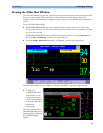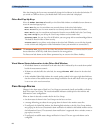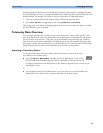
Changing the Volume of the QRS Tone 6 ECG, Arrhythmia, and ST Monitoring
95
To Change the Size of all the ECG Waves
To change the size of all the ECG waves on the screen by a fixed adjustment factor,
1 In the Setup ECG Lead menu, select Adjust Size.
2 Select the required adjustment factor from the line of pop-up keys.
–
Size x0.5 to halve the wave size
–
Size x1 to display the wave without zoom
–
Size x2 to double the wave size
–
Size x4: to multiply the wave size by four
–
Previous Size: to return one step to the previous size
–
Auto Size: to let the monitor choose the optimal adjustment factor for all the ECG waves.
Changing the Volume of the QRS Tone
The QRS tone is derived from either the HR or Pulse, depending on which is currently selected as the
alarm source. The QRS volume can be set from 0 to 10 (0 means off).
♦ To change the QRS volume, in the Setup ECG menu select QRS Volume and then select the
appropriate volume from the pop-up list.
Changing the ECG Filter Settings
The ECG filter setting defines how ECG waves are smoothed. A letter indicating the filter type is
shown underneath the lead label on the monitor display. Filter settings do not affect ST measurement.
12-Lead ECG captures are analyzed in the PIC using the diagnostic filter and displayed on the
Information Center using the filter setting from the bedside monitor. Any changes you make to the
filter setting at the bedside monitor may take up to a minute to be reflected at a connected Information
Center. For this reason, you should wait one minute between changing the filter setting and sending a
12-lead capture to an Information Center.
♦ To change the filter setting, in the Setup ECG menu, select Filter and then select the
appropriate setting.
– Monitor: Use under normal measurement conditions.
– Filter: The filter reduces interference to the signal. It should be used if the signal is distorted
by high frequency or low frequency interference. High frequency interference usually results in
large amplitude spikes making the ECG signal look irregular. Low frequency interference usually
leads to a wandering or rough baseline. In the operating room, the Filter reduces artifacts and
interference from electrosurgical units. Under normal measurement conditions, selecting
Filter may suppress the QRS complexes too much and thus interfere with the clinical
evaluation of the ECG displayed on the monitor. This does not affect the ECG analysis
performed by the monitor.
If
AutoFilter is set to On in Configuration Mode, the filter setting will automatically be set to
Filter if electromagnetic interference is detected.


















